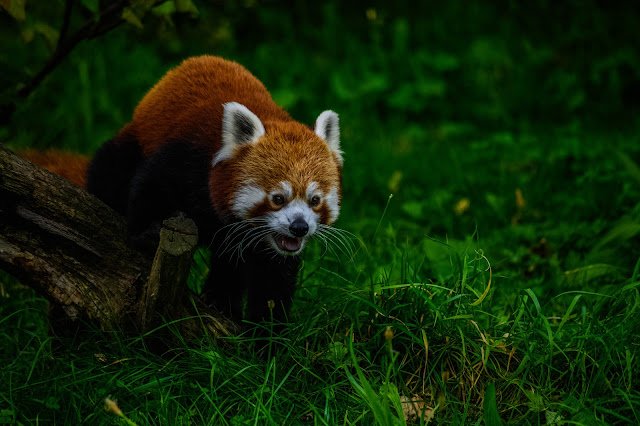
Think of the red panda as a delicate thread in nature’s grand tapestry. When you pull at one thread, the whole piece can start to unravel. That’s a bit like what’s happening with the red panda and its environment. Its survival is tied closely to the health of its habitat in the mountains of Asia. In this article, we’ll dive deep into the current status of red pandas, what’s putting them at risk, and what’s being done globally to protect them.
What Makes the Red Panda Unique?
Red pandas are truly one-of-a-kind. They belong to their own family, Ailuridae, which is separate from that of the giant panda, even though they share a name. These small mammals are about the size of a domestic cat but have a fluffy tail that can be as long as their body. Their striking reddish-brown fur provides excellent camouflage in the trees where they spend most of their lives. You might picture them hanging out in the treetops, munching on bamboo leaves or fruits like they’re savoring a fine meal.
Their diet is one reason red pandas face challenges. Unlike giant pandas, which eat bamboo almost exclusively, red pandas have a more varied diet. They consume fruits, acorns, and even insects. However, about 95% of their diet is bamboo. This reliance on bamboo makes them vulnerable because bamboo forests are disappearing due to human activity and habitat loss.
The Endangered Status of Red Pandas
So, how endangered are red pandas? According to the International Union for Conservation of Nature (IUCN), red pandas are classified as endangered. Current estimates suggest that there are fewer than 10,000 individuals left in the wild. This number isn’t just a statistic; it represents a significant decline due to various threats.
The primary factors contributing to their endangered status include habitat loss, poaching, and climate change. As forests are cleared for agriculture, the red panda’s home shrinks, leaving them with fewer resources to survive. Poaching also poses a threat, as their beautiful fur is sought after in illegal wildlife trade. Climate change impacts bamboo availability, which exacerbates the struggles red pandas face.
Threats to the Red Panda Population
Understanding the specific threats to red pandas is crucial in the fight for their survival. Here are the key issues impacting their habitat:
- Deforestation: As we build roads, towns, and agricultural land, red pandas lose the forests they need to thrive. A fragmented habitat makes it hard for them to find food and mates.
- Climate Change: Warmer temperatures can alter the delicate balance of the red panda’s ecosystem. Bamboo species may struggle to grow, leading to food shortages.
- Poaching: Unfortunately, some people hunt red pandas for their fur or capture them for the illegal pet trade. This directly reduces their numbers and disrupts populations.
- Human Encroachment: As people move into their habitats, red pandas may become more vulnerable to conflicts, such as being hit by vehicles or losing access to food.
Addressing these threats is vital for the red panda’s future. It’s a delicate balance, and we need to advocate for their survival.
Global Conservation Efforts
Now that we understand the threats, let’s look at what’s being done to help red pandas. Various organizations and governments are stepping up their game to protect these beloved animals:
- Protected Areas: Many countries have established national parks and reserves to safeguard red panda habitats. These areas provide safe havens where they can live and breed without human interference.
- Community Engagement: Local communities play a crucial role in conservation. Education programs teach people about the importance of red pandas and their habitats, encouraging sustainable practices.
- Research and Monitoring: Conservationists are studying red panda populations to gather data on their habits and health. This research is vital in forming effective action plans and policies.
- Legislation: Many countries have laws against poaching and illegal trade of red pandas. These legal frameworks help deter poachers and protect the remaining populations.
Each of these efforts contributes to the larger mission of preserving the red panda and its ecosystem.
How You Can Help Red Pandas
You might be wondering how you, as an individual, can contribute to the conservation of red pandas. Here are some simple but impactful actions you can take:
- Raise Awareness: Share information about red pandas and their conservation status on social media. The more people know, the better the chances for change.
- Support Conservation Organizations: Consider donating to or volunteering with groups dedicated to red panda conservation. Your support can help fund critical projects.
- Practice Sustainable Living: Reducing your carbon footprint can lessen the impacts of climate change on their habitats. Simple actions like using less plastic and conserving energy make a difference.
- Visit Zoos or Sanctuaries: If you’re interested in red pandas, visiting accredited zoos or sanctuaries can provide education and support their conservation efforts.
You might be surprised by how small actions can add up to make a significant impact!
The Role of Education in Conservation
Education is a powerful tool in conservation efforts. By teaching people about red pandas and why they matter, we cultivate a sense of responsibility for protecting them. Here’s how education plays a role:
- Building Connections: When people learn about the beauty and uniqueness of red pandas, they are more likely to care about their fate.
- Encouraging Action: Educational programs can motivate individuals and communities to take steps toward conservation, whether through local initiatives or larger global efforts.
- Fostering Research: Education encourages future generations to pursue careers in conservation, leading to new ideas and strategies for protecting vulnerable species.
We can’t underestimate the power of knowledge in sparking change.
To sum it up, red pandas are indeed endangered, and their survival hinges on our awareness and action. It’s like we’re all part of a team striving to keep this fluffy bundle of joy in our world. By understanding the threats they face and supporting ongoing conservation efforts, we can make a difference together.
So, the next time you see a cute red panda, remember that behind that adorable face is a creature needing our help. Whether through education, advocacy, or simply sharing information, we all have a role to play in ensuring their future. Let’s hold onto that thread in nature’s tapestry and help it thrive!

